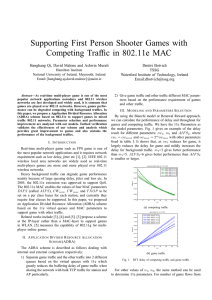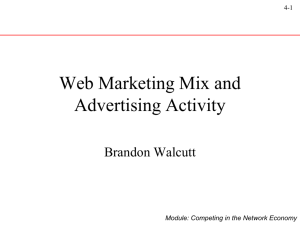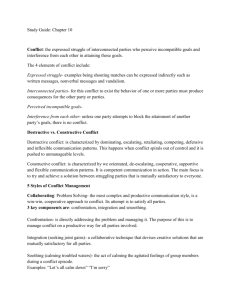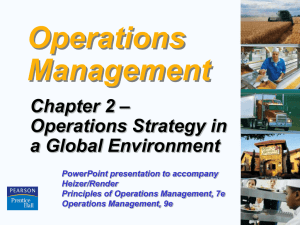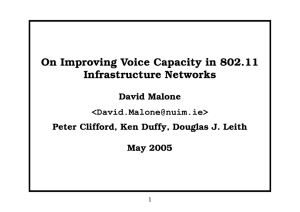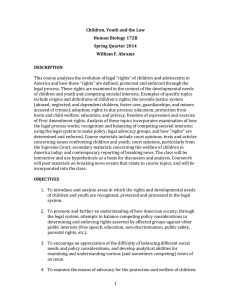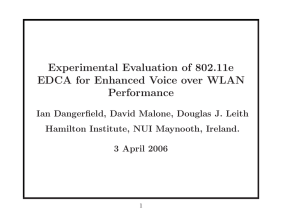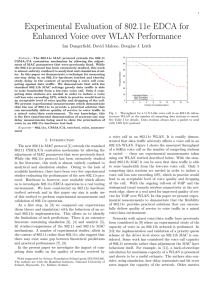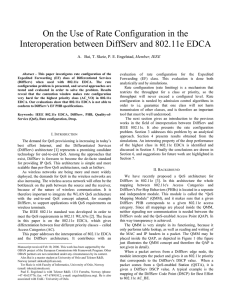Supporting First Person Shooter Games with Competing Traffic in 802.11e MAC
advertisement
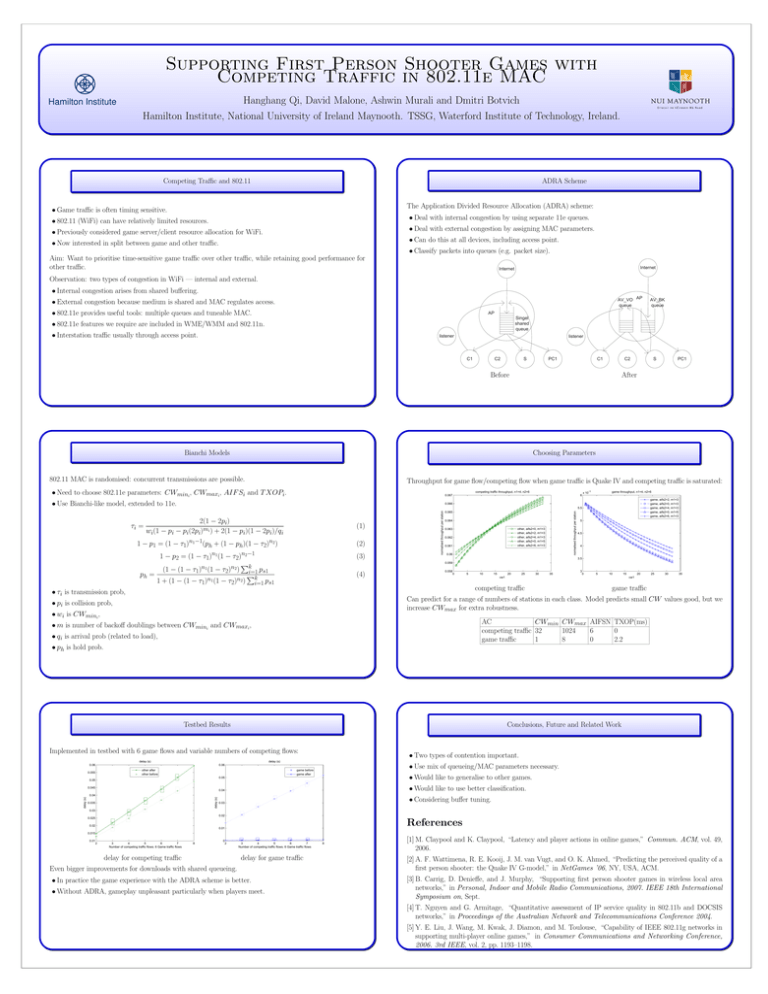
Supporting First Person Shooter Games with Competing Traffic in 802.11e MAC Hanghang Qi, David Malone, Ashwin Murali and Dmitri Botvich Hamilton Institute, National University of Ireland Maynooth. TSSG, Waterford Institute of Technology, Ireland. Competing Traffic and 802.11 ADRA Scheme The Application Divided Resource Allocation (ADRA) scheme: • Game traffic is often timing sensitive. • Deal with internal congestion by using separate 11e queues. • 802.11 (WiFi) can have relatively limited resources. • Deal with external congestion by assigning MAC parameters. • Previously considered game server/client resource allocation for WiFi. • Can do this at all devices, including access point. • Now interested in split between game and other traffic. Aim: Want to prioritise time-sensitive game traffic over other traffic, while retaining good performance for other traffic. • Classify packets into queues (e.g. packet size). Internet Internet Observation: two types of congestion in WiFi — internal and external. • Internal congestion arises from shared buffering. AV_VO AP queue • External congestion because medium is shared and MAC regulates access. • 802.11e provides useful tools: multiple queues and tuneable MAC. AV_BK queue AP Singel shared queue • 802.11e features we require are included in WME/WMM and 802.11n. • Interstation traffic usually through access point. listener listener C1 C2 S PC1 C1 C2 Before S PC1 After Bianchi Models Choosing Parameters 802.11 MAC is randomised: concurrent transmissions are possible. Throughput for game flow/competing flow when game traffic is Quake IV and competing traffic is saturated: • Need to choose 802.11e parameters: CWmini , CWmaxi , AIF Si and T XOPi. • Use Bianchi-like model, extended to 11e. −3 competing traffic throughput, n1=4, n2=6 0.067 6 game throughput, n1=4, n2=6 x 10 game, aifs2=2, m1=3 game, aifs2=0, m1=3 game, aifs2=4, m1=3 game, aifs2=0, m1=5 game, aifs2=6, m1=3 0.066 (1) 1 − p1 = (1 − τ1)n1−1(ph + (1 − ph)(1 − τ2)n2 ) (2) 1 − p2 = (1 − τ1)n1 (1 − τ2)n2−1 Pk n n 1 2 (1 − (1 − τ1) (1 − τ2) ) i=1 ps1 ph = Pk n n 1 2 1 + (1 − (1 − τ1) (1 − τ2) ) i=1 ps1 (3) 0.065 normalised throughput per station 2(1 − 2pi) τi = wi(1 − pi − pi(2pi)mi ) + 2(1 − pi)(1 − 2pi)/qi normalised throughput per station 5.5 0.064 other, aifs2=0, m1=3 other, aifs2=2, m1=3 other, aifs2=4, m1=3 other, aifs2=0, m1=5 other, aifs2=6, m1=3 0.063 0.062 0.061 0.06 5 4.5 4 3.5 0.059 (4) 0.058 0 5 10 15 20 25 30 35 0 5 10 cw1 15 20 25 30 35 cw1 competing traffic • τi is transmission prob, 3 game traffic Can predict for a range of numbers of stations in each class. Model predicts small CW values good, but we increase CWmax for extra robustness. • pi is collision prob, • wi is CWmini , AC CWmin CWmax AIFSN TXOP(ms) competing traffic 32 1024 6 0 game traffic 1 8 0 2.2 • m is number of backoff doublings between CWmini and CWmaxi , • qi is arrival prob (related to load), • ph is hold prob. Testbed Results Conclusions, Future and Related Work Implemented in testbed with 6 game flows and variable numbers of competing flows: delay (s) • Two types of contention important. delay (s) 0.06 • Use mix of queueing/MAC parameters necessary. 0.06 other after other before 0.055 game before game after 0.05 0.045 0.05 • Would like to generalise to other games. 0.04 • Would like to use better classification. 0.03 • Considering buffer tuning. delay (s) delay (s) 0.04 0.035 0.03 0.02 0.025 References 0.02 0.01 0.015 0.01 2 3 4 5 6 7 Number of competing traffic flows. 6 Game traffic flows 8 0 2 3 4 5 6 7 Number of competing traffic flows. 6 Game traffic flows delay for competing traffic delay for game traffic Even bigger improvements for downloads with shared queueing. • In practice the game experience with the ADRA scheme is better. • Without ADRA, gameplay unpleasant particularly when players meet. 8 [1] M. Claypool and K. Claypool, “Latency and player actions in online games,” Commun. ACM, vol. 49, 2006. [2] A. F. Wattimena, R. E. Kooij, J. M. van Vugt, and O. K. Ahmed, “Predicting the perceived quality of a first person shooter: the Quake IV G-model,” in NetGames ’06, NY, USA, ACM. [3] B. Carrig, D. Denieffe, and J. Murphy, “Supporting first person shooter games in wireless local area networks,” in Personal, Indoor and Mobile Radio Communications, 2007. IEEE 18th International Symposium on, Sept. [4] T. Nguyen and G. Armitage, “Quantitative assessment of IP service quality in 802.11b and DOCSIS networks,” in Proceedings of the Australian Network and Telecommunications Conference 2004. [5] Y. E. Liu, J. Wang, M. Kwak, J. Diamon, and M. Toulouse, “Capability of IEEE 802.11g networks in supporting multi-player online games,” in Consumer Communications and Networking Conference, 2006. 3rd IEEE, vol. 2, pp. 1193–1198.
